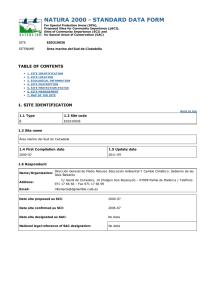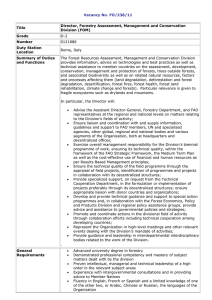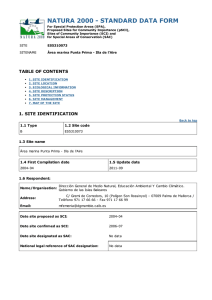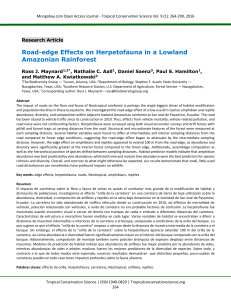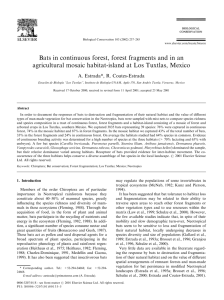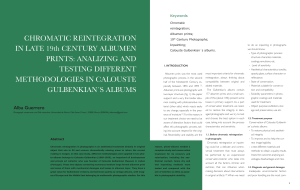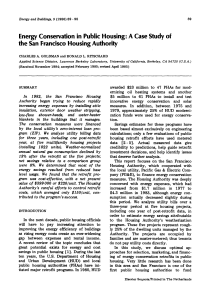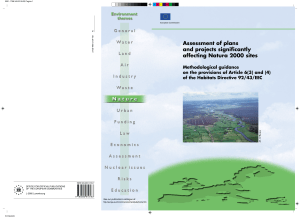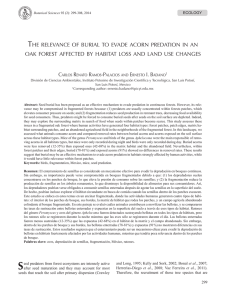LIFE AIAKO HARRIA - Conservation and restoration of "Aiako Harria
Anuncio
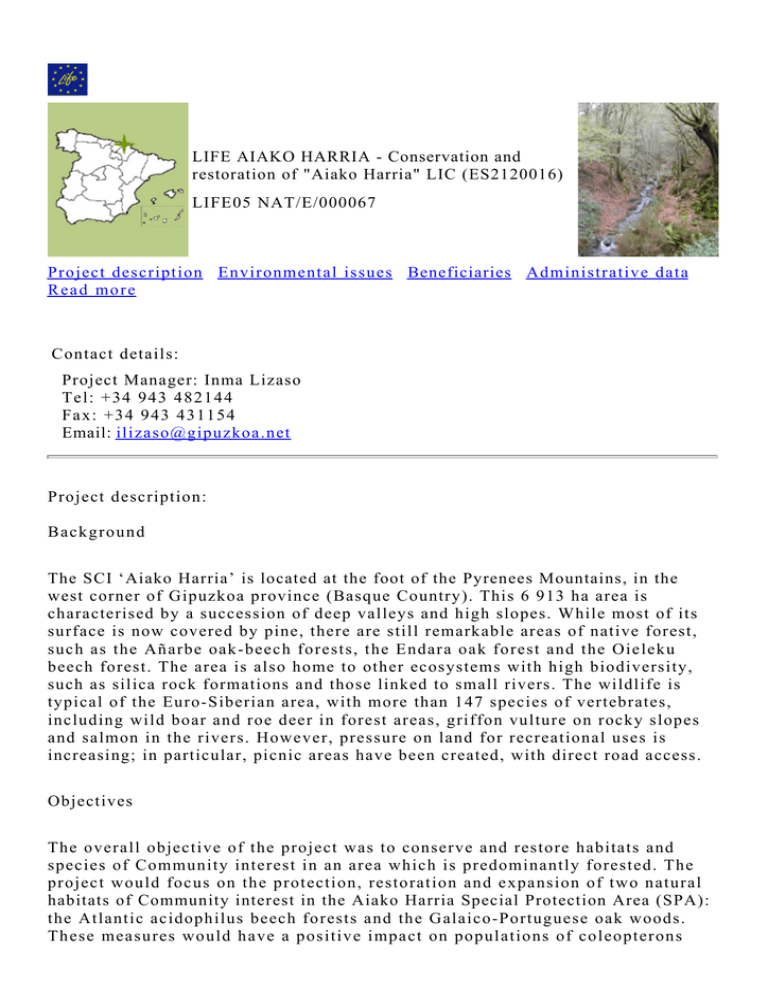
LIFE AIAKO HARRIA - Conservation and restoration of "Aiako Harria" LIC (ES2120016) LIFE05 NAT/E/000067 Project description Environmental issues Beneficiaries Administrative data R e a d m o r e Contact details: Project Manager: Inma Lizaso Tel: +34 943 482144 Fax: +34 943 431154 Email: [email protected] Project description: Background The SCI ‘Aiako Harria’ is located at the foot of the Pyrenees Mountains, in the west corner of Gipuzkoa province (Basque Country). This 6 913 ha area is characterised by a succession of deep valleys and high slopes. While most of its surface is now covered by pine, there are still remarkable areas of native forest, such as the Añarbe oak-beech forests, the Endara oak forest and the Oieleku beech forest. The area is also home to other ecosystems with high biodiversity, such as silica rock formations and those linked to small rivers. The wildlife is typical of the Euro-Siberian area, with more than 147 species of vertebrates, including wild boar and roe deer in forest areas, griffon vulture on rocky slopes and salmon in the rivers. However, pressure on land for recreational uses is increasing; in particular, picnic areas have been created, with direct road access. Objectives The overall objective of the project was to conserve and restore habitats and species of Community interest in an area which is predominantly forested. The project would focus on the protection, restoration and expansion of two natural habitats of Community interest in the Aiako Harria Special Protection Area (SPA): the Atlantic acidophilus beech forests and the Galaico-Portuguese oak woods. These measures would have a positive impact on populations of coleopterons (beetles) such as Rosalia longicorn (Rosalia alpine) and stag beetle (L u c a n u s (beetles) such as Rosalia longicorn (Rosalia alpine) and stag beetle (L u c a n u s cervus), and would allow the establishment of others, including the hermit beetle (O s m o d e r m a e r e m i t e) and the great Capricorn beetle (Cerambyx cerdo), all of which are of Community interest (and, as such, listed in Annex II of the Habitats Directive). Measures would also be taken to restore fluvial habitats and species, particularly the Alpine snowbell (Soldanella villosa), given the importance of Aiako Harria for the global conservation of this species. Results The project completed most of the foreseen actions by its end date. It contributed to the restoration and improvement of the conservation status of the target Community habitats and species populations. The actions linked to the improvement of the Pyrenean Desman (Galemys pyrenaicus) were not undertaken, however. After a thorough analysis of the constraints and collateral effects on the habitat alluvial forests with Alnus glutinosa and Fraxinus excelsior , the cost-effectiveness of the actions was not sufficiently clear. A major achievement of the project was the launch of several innovative lines of research (such as entomofauna monitoring). Such research initiatives are expected to yield useful information for implementing sustainable forestry management. Prior to the project, information on techniques to improve the conservation status of the forest ecosystem was lacking in Spain. The project introduced some pioneering techniques that can carried out in other similar areas. Specific results of the project include: Drawing up of a restoration plan for the replacement of 287.7 ha of land (19% more than initially expected) covered with exotic conifer masses with habitats of Community interest in the communal forestry areas ‘Añarbe’, ‘Usoko-Epelerreka’ and ‘Kausua’. Purchase of 54.2 ha (8% more than foreseen) of private land to restore habitats Atlantic acidophilous beech forests and Galicio-Portuguese oak woods with Quercus pyrenaica.ha Study of the conservation status of Galemys pyrenaicus h a b i t a t (Pyrenean Desman) and minimum flow critic for species in the stream Tornola (basin of the river Oiartzun). Study of the physical habitat and retention capacity of the riverbeds flowing into the Añarbe reservoir. This study was undertaken with the objective of determining the simplest riverbeds in terms of structure and functionality where wood introduction was conducted. Designing of a technical project to increase the structural complexity and the retention capacity of organic matter and sediments in the riverbeds flowing into the Añarbe reservoir. Determination of the habitat cartography in EUNIS format in the context of the SCI. Study on the diversity of forest invertebrate species of Community interest in the context of the SCI, emphasising threatened coleopterons species typical of forest environments and dependent on the availability of dead or decrepit wood, included in the Annexes II and IV of the Directive 92/43/CEE. Several key improvements were also made to the following habitats: Acidophilus beech forest (habitat 9120): Increase of the area by 236 ha, starting from grown up exotic conifer plantations (38% more than the existing habitat surface in 2005) and protection of indigenous understorey in 22.5 ha of fully grown exotic broadleaved plantations. Improvement of the conservation status of 32 ha by means of increasing the structural complexity of the habitat. Natural regeneration started in 20 ha of the Oianleku acidophilous beech. Restoration of an additional 64 ha of this habitat after the project end. Galicia-Portuguese oak wood (habitat 9230): Increase of the area by 12 ha (more than 50% of the mapped area in 2006). Improvement of the conservation status of 3.3 ha by means of the creation of a firebreak band. Rivers and riparian habitat (91E0*): Increase of the structural complexity of the riparian habitat along 700 m of four different streams. Increase of the fish biomass, invertebrate density and dead leaves and sediments retention. Contribution to the improvement of the water resources of the Añarbe reservoir. Increase of the knowledge on the habitat, its ecology, dynamic, and measures for better management. Finally, the conservation of the 1 ha area, where the Killarney fern (T r i c h o m a n e s speciosum) can be found, and a strip of 20 m in each side of the riverbeds of the upstream tributaries of the stream ‘Karrika’ for the protection of the Hairy snowbell (Soldanella villosa) was ensured. A wide dissemination campaign of the project’s result was carried out. As well, bi-monthly news bulletins, an interactive CD and booklet for schoolchildren and teachers and a travelling exhibition, the project organised an ‘International Workshop on Conservation, Restoration and Management of forest and fluvial SCIs’. Even the external companies involved in the project helped to publicise the project, which has led to a shift in attitude in favour of forest conservation and restoration within the SCI Aiako Harria among the general public and private landowners. As a result, the pollarding tradition is gradually being restored in order to maximise biodiversity. Further information on the project can be found in the project's layman report and After-LIFE Conservation Plan (see "Read more" section). Top Environmental issues addressed: Themes Species - Invertebrates Keywords forest ecosystem‚ protected area‚ nature conservation‚ land purchase‚ mountainous area Target EU Legislation Nature protection and Biodiversity Directive 79/409 - Conservation of wild birds (02.04.1979) Directive 92/43 - Conservation of natural habitats and of wild fauna and flora- Habitats Directiv ... Target species Cerambyx cerdo Galemys pyrenaicus Lucanus cervus Osmoderma eremita Rosalia alpina Soldanella villosa Trichomanes speciosum Target Habitat types 9120 - Atlantic acidophilous beech forests with Ilex and sometimes also Taxus in the shrublayer (Quercion robori-petraeae or Ilici-Fagenion) 9230 - Galicio-Portuguese oak woods with Quercus robur and Quercus pyrenaica Natura 2000 sites SCI ES2120016 Aiako Harria Top Beneficiaries: Coordinator Type of organisation Description Direción General de Montes y Medio Natural.Departamento para el Desarrollo del Medio Rural Regional authority The Mountains and Natural Environment General Directorate is the public authority in charge of forestry, fisheries and nature conservation in the province of Gipuzkoa (Basque Country). The Directorate also manages the natural parks of Aiako Harria, Pagoeta, Partners Aralar and the protected biotope of Inurritza and the Leitzaran river. All these sites have been proposed as Special Protection Areas (SPAs) by the Basque Government. Ayuntamiento de Irún, Spain Basoa Fundazioa, Spain Naturgintza Fundazioa, Spain Top Administrative data: Project reference Duration Total budget EU contribution Project location LIFE05 NAT/E/000067 01-OCT-2005 to 31-MAR -2010 2,260,318.00 € 1,130,159.00 € País Vasco(España) Top Read more: Brochure Publication: After-LIFE Conservation Plan Publication: Case study Publication: Layman report Publication: Layman report Publication: Research findings Publication: Research findings Publication: Research findings Title: "LIFE AIAKO HARRIA : vivir el bosque : bazo bizia" (1.497 KB) Editor: Diputación Foral de Gipuzkoa No of pages: 12 Title: After-LIFE Conservation Plan Year: 2009 No of pages: 11 Title: "Vertebrados indicadores del estado de conservación del hayedo de Oianleku" (2.815 KB) Author: González-Esteban J., Villate I. Year: 2007 Editor: DESMA Estudios Ambientales No of pages: 37 Title: Layman report Year: 2009 No of pages: 18 Title: Layman report Year: 2009 No of pages: 18 Title: "Briófitos del hayedo de Oileku : seguimiento de comunidades epifíticas y lignícolas. Actualizaciones" (3.325 KB) Author: Infante Sanchez M., Heras Pérez P. Year: 2008 Editor: Dirección de Montes y Medio Natural/Diputación For No of pages: 77 Title: "Informe del seguimiento del proyecto destinado a aumentar la complejidad de los cauces vertientes al embalse de añarbe" (2.202 KB) Author: Díez J., Elosegi A. Year: 2009 No of pages: 48 Title: "Proyecto de estudio de los líquenes y Publication: Research findings Publication: Research findings Publication: Research findings Publication: Research findings Publication: Technical report Slides Presentation Title: "Proyecto de estudio de los líquenes y hongos liquenícolas de Oieleku" (251 KB) Author: Etayo Salazar, Javier No of pages: 46 Title: "Detección de las especies de invertebrados de interés comunitario, determinación del estado de sus poblaciones y medidas para su conservación, en el L.I.C. Aiako Harria : campaña 2006" (688 KB) Author: Pagola Carte, Santiago Year: 2007 Editor: Asociación Gipuzkoana de Entomología Title: "Inventario y seguimiento de la entomofauna del hayedo de Oieleku (Oiartzun, Parque Natural de Aiako Harria) – Campaña 2008" (8.388 KB) Author: Pagola Carte, Santiago Year: 2008 Editor: Asociación Gipuzkoana de Entomología No of pages: 106 Title: "Análisis de los resultados logrados en los tratamientos realizados en 2005 en el hayedo Oieleku (Parque Natural de Aiako Harria)" (3.366 KB) Author: Estibaliz Arbelaitz Ubegun Year: 2005 Editor: Aranzadi Institutua No of pages: 26 Title: Project's final report Year: 2010 No of pages: 59 Title: "Plan de mejoramiento del estado de conservación del hayedo Oieleku (PNAH)" (1.294 KB) Author: Uriarte Arandia, Lorena Editor: Aranzadi Institutua No of pages: 38 Top Project description Environmental issues Beneficiaries Administrative data R e a d m o r e

